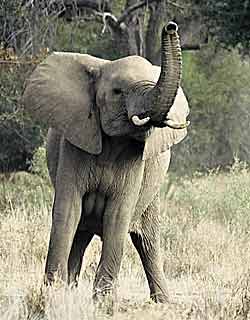Contact Details: Scotch Macaskill, Dirt Road Traders, Currys Post Road, Howick, KwaZulu-Natal, South Africa. Tel: +27 (0)82 578 2329. Privacy: Your privacy is guaranteed. See our Privacy Policy for more. This site accepts advertising and other forms of compensation - see Disclosure and Advertising for details. Site updated: 2022. Copyright © 2002 - 2022 Scotch Macaskill

| ||||||||||
|
||||||||||
|
SEE ALL
|
Social Behaviour and Communication in Elephants - 2Acoustic Communication Acoustic communication refers to sound production and hearing. Elephants have a wide range of sounds that they can emit all with different intensities and for different purposes such as securing their defence, attracting mates, co-ordinating movement and generally announcing their needs. These sounds include growls, trumpets, squeals, skrieks and low frequency vocalisations. Growling and rumbling is the most commonly used vocal production in elephants and is used as a means of communication between individuals and families; however, it can also be used in an aggressive tone between females and calves as a disciplinary measure. (Wilson, 2000) Video of Angry Elephants Trumpeting & Rumbling
Scientists have now discovered that elephants can produce infrasonic sound from 1- 20Hz that humans cannot hear and these sounds can travel over long distances, as well as seismic signals, which are like mini earthquakes that allow elephants to position each other in relation to their own location. (Braden, 2003) One study suggested that low frequency vocalisations transmitted between females is used as a reproductive strategy by males, specifically in African elephants (Loxonodonta africana). The levels of intensity of these vocalisations vary depending on which reproductive state the females are in. Males use these vocalisations as a strategy to search for herds with high vocal production as this means that they are close to the ovulation period. Males also rely on passive communication between herds by "eavesdropping" to increase his chances of locating a female in the follicular phase and when in close proximity, using chemical and visual cues as more reliable signals. (Leong et al 2003) Another study suggests that this "eavesdropping" tactic can also provide an opportunity to recognise signals by conspecifics and this was supported as playback calls made from family and bond groups resulted in a strong positive response of the elephants used in the experiment. (McComb et al 2000) Therefore, indicating that elephants have a highly organised network as they can develop and accumulate the knowledge to recognise signals from extensive populations of conspecifics. Visual Communication
Visual communication refers to expressions, postures, displays or movement of ears, jaws, trunk and the like, and how elephants are able to use their sense of sight to determine what message the signaller is trying to portray. Head and trunk postures can be used for different types of communication such as communication between individuals but also between rivals to display threats (See Fig 3). These visual signals can be of either high or low intensity; at low intensity the animal stands tall, but at high intensity i.e. during threat, the animal moves forward towards the enemy lifting its ears and extending its trunk forward. The "forward trunk swish" signal is used towards a smaller rival where the trunk is rolled up and is suddenly lashed forward. (Wilson, 2000) To signal dominance, the elephant will appear taller, with its head high above its shoulders and ears spread wide. A subordinate elephant appears the opposite, with its ears kept back and its head lying low. (Granli et al 2006) The trunk is thus an important aspect in visual communication. Chemical Communication Chemical communication is an energetically efficient process which involves the secretion of chemical signals
as long lasting messages. They produce a wide range of odour signals and these odours are carried by secretions
from various sources such as skin glands, reproductive tract, urine, faeces and expired air.
Secretions are also produced from the temporal gland; a multi-lobed sac which secretes a viscous, strong smelling liquid located between the eye and ear (See Fig 4). These secretions are released in great quantities especially when the animal is excited or under stress, suggesting that the gland is under autonomic control. (Wilson 2000) These odour signals are sensed by the receivers' chemo-receptors and are used for many communicative functions such as trail marking, individual recognition and alarm. Elephants have a highly developed olfactory system which has given them an acute sense of smell that enables the elephant to transfer the chemical into a message. It has been discovered that elephants can discriminate human friends from unfamiliar humans; African elephants situated in Kenya's Amboseli National Park do not react to the scent or colour of local farmers' garments, but react aggressively and hysterically to the scent and colour of clothing worn by Masai Warriors. (McKenna, 2007) This illustrates that elephants can learn by association as different ethnic groups can have different risks to elephants. Elephants also use chemical communication to detect an individuals' reproductive state. Females prefer males in musth which means they have high testosterone levels and because of this they secrete a fluid from their temporal gland. While in musth they also dribble urine that carries a powerful odour which females can detect. Musth males are in a good physical condition (Wyatt, 2003) and are more dominant competitively so females prefer to mate with them rather than those not in the musth phase. This strategy applies to both African and Asian (Elephas maximus) elephants. (Ramussen et al 1998) Tactile Communication
Tactile communication is how they use touch to communicate between individuals and they do this primarily with their trunk. Their trunk is used for a variety of different functions such as drinking water, ripping vegetation off tall trees (See Fig 5), smelling individuals and so on, but more importantly for their tactile sense. Elephants use their trunks to explore unfamiliar territories, objects and to exchange touches with unfamiliar individuals passing through the bush. With regards to reproduction, courting elephants communicate with one another by intertwining their trunks. In addition, feet are also important for their tactile sense as they have soft skin which can sense and hear seismic vibrations through the ground produced by other elephants. The interiors of elephants' feet are filled with Pacinian corpuscles, vibration sensors that are layered and covered in a slimy gel. Vibrations are transmitted through these layers which result in a nerve signal that is sent to the brain. Their trunks are also used in similar fashion by simply laying them on the ground as they too contain vibration sensors. (Braden, 2003) Continue to Social Behaviour and Communication in Elephants Pg 3
|
|||||||||
|
| ||||||||||


